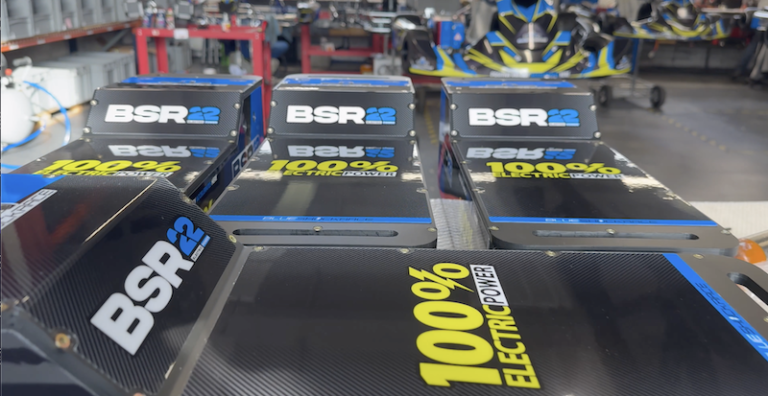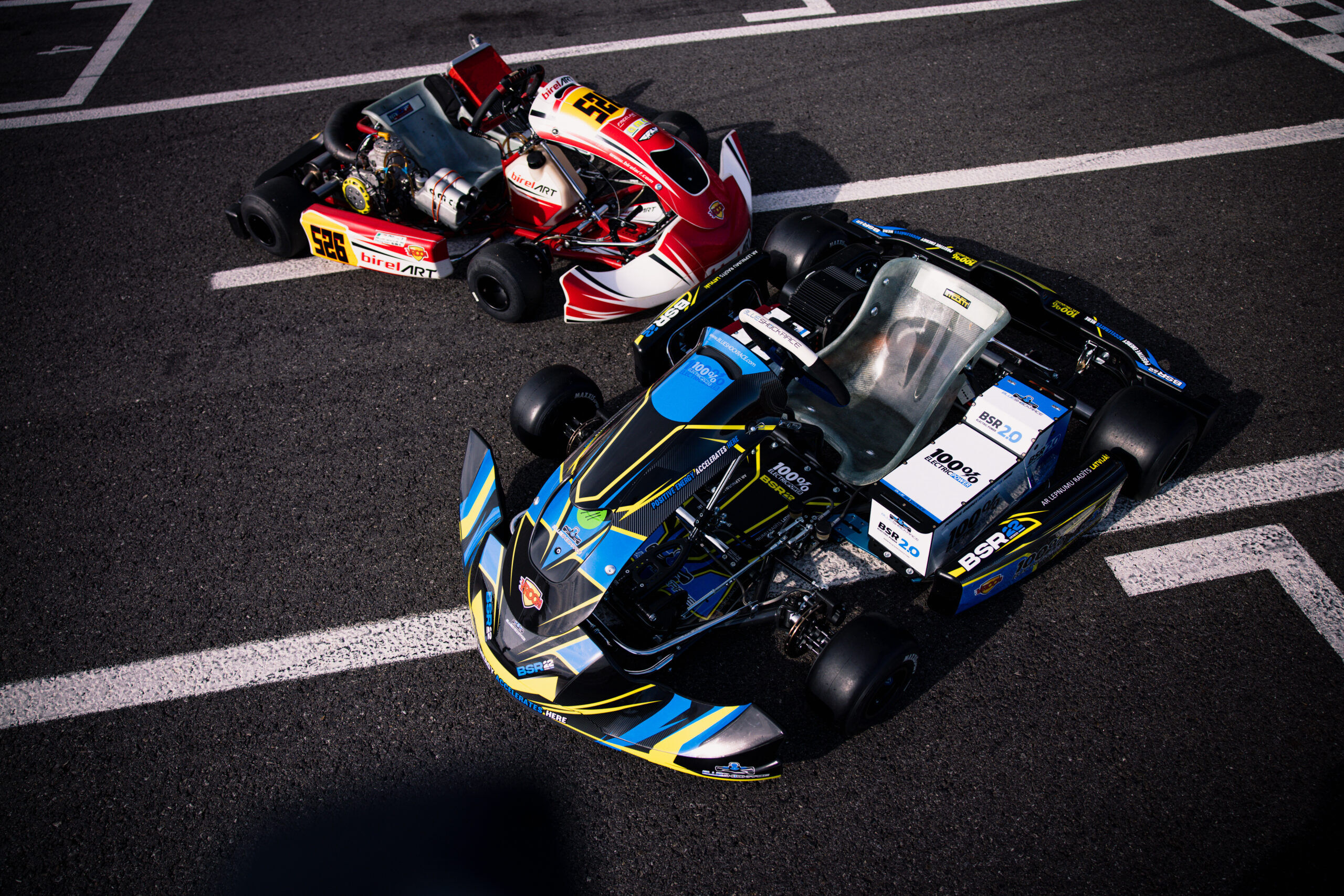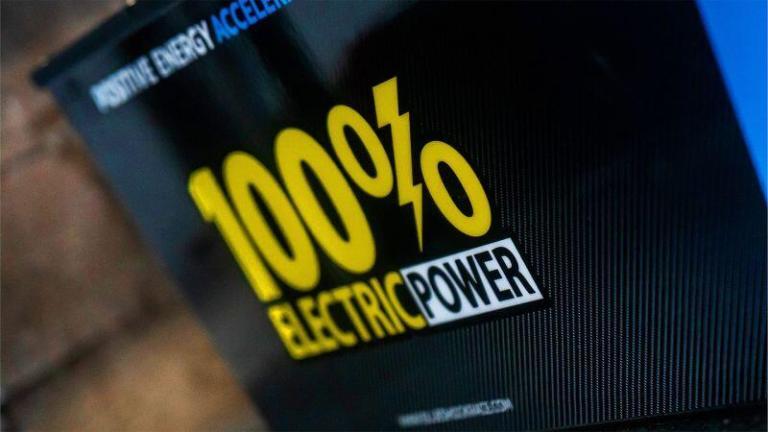- blog
- Lithium-Ion Battery,
- BSR,
- Electric Race Kart
- Electric power – the future is now!

Unexpected power and performance for an electric engine, the BSR 2.0 25+ kW power unit by Blue Shock Race balances high initial costs to practically zero maintenance. We have tested in Franciacorta the most performing power unit! (by C. Forni – pictures M. Segato)
Even though many of us love the sound, the aggressiveness, and the “heart” of internal combustion engines, it is evident that the future is electric. No noise pollution, in addition to none of the more traditional exhaust gas pollution, permits to overcome the growing limits set for kart tracks and events. Blue Shock Race, the Latvian company based in Liepāja, has today an extremely interesting high-quality electric engine offer for every need. We have tested the most powerful unit, the 25+ kW one, more exactly 33kW (45HP), at the Franciacorta track, and sincerely have been well impressed.
Blue Shock Race
Born in 2014, the Latvian company has since then worked with the aim of offering electric power solutions, starting from the base of motorsports, karting. The specific work has been aimed at obtaining the best reliability and quality, balancing performance versus battery life, and at reducing the weight of the power unit and the battery.
Today Blue Shock Race has an amazingly complete offer. From the “Bambino” power unit of 1.5 kW, to the 7kW of the “Micro” engine, to 18kW, 25kW, and 33kW. The latter we tested in Franciacorta. The 1.5 kW electric engine works on 48V 150A electricity input and has an adjustable maximum speed is 55 km/h (34 mph). The total weight is 18 kg (39 lbs). The maximum racing time is more than 30 minutes. The 7kW power unit works with a 48V 200A controller and adjustable maximum speed is 90 km/h (56 mph). The weight of the complete power unit is 31 kg (38 lbs). The racing time is more than 18 minutes.
The 18kW works with a 96V 350A and an adjustable maximum speed of 110 km/h (68 mph). The total weight, engine plus battery and controller, is 40 kg (88 lbs). The racing time is more than 16 minutes. The 25 kW power unit, also works with a 96V and 350A controller. The total weight is 53 Kg (117 lbs). The maximum adjustable speed is 125 km/h (78 mph). The single session can last above 18 minutes. Finally, the 25+ kW engine, which delivers 33 kW (44.9 HP), works with the 96V 350A converter. The maximum speed reached is 135 km/h (84 mph).
Price versus maintenance
As expectable, the cost is high, as it is for any electric vehicle, as the Li-ion battery units have a very high cost. You can check all details on https://blueshockrace.com/
Now, considering a power unit used for high-level kart racing, where an internal combustion engine needs partial maintenance every race and complete maintenance every 3 races (average data), the related costs are definitely high. The piston, reed valves, connecting rod, crankshaft bearings, head and foot of the conrod bearings, the conrod itself, oil seal rings, carburetor membranes (if present) and check, exhaust pipe and spark plug are all elements that need to be changed periodically. In addition, an internal combustion engine works with really high temperatures and can seize with the need for a new piston, lapping or grinding in the worse cases of the cylinder, and sometimes even grinding or change of the cylinder head when a part of the piston, like the piston ring, brakes and damages the combustion chamber area. Also, having a liquid-cooled engine requires care for the cooling system pump and O-rings that connect the latter to the axle. The liquid cooling system tubes and the radiator are additional elements that need to be looked after, this is a fact.
All this is practically absent on an air-cooled brushless electric engine, where the only part to keep under control is the battery. The air cooling and the absence of brushes avoid any possible wear. The battery can be checked with a dedicated app that shows the conditions of every single Li-ion cell. The battery has 1 year of unlimited warranty, meaning in that year the kart can run unlimited kilometres and keep the warranty. Blue Shock Race can anyway periodically refresh the battery to bring it back to almost 100% of its initial capacities. Only other maintenance? The chain!
Battery and recharging
The recharging time of all the batteries of all the Blue Shock Race power units is between 1 hour to 90 minutes to go from 20% to 90% of the charge. What is extremely positive is the fact that performance practically never changes even going well below 20% of charge.
In addition, according to Blue Shock Race, is the fact that the converters of electricity work with either 48V or 96V, which is under low voltage regulations for most of the world. Such a low value increases safety compared to other electric solutions working with more than 300V. Moreover, the Battery Management System is set to switch off power the very moment there is an overheating of the battery.
The test setup
Franciacorta circuit is definitely a high-level and fast track where international competitions take place. We have so invited by Blue Shock Race to test the top-of-the-line power unit, the 25kW + (33kW-45HP) electric engine. The test has been done on a warm day with dry track, but not very high grip, as no competition was planned in the immediate coming days. The power unit was initially mounted on the Birel KZ chassis brought by Blue Shock Race. For a more precise test, we then moved the unit to a Birel KZ chassis owned by the professional tester, Paolo Oliva. In such a way, Paolo was able to drive a chassis he knew, even though evidently with a net change in weights. In fact, the electric power unit with all the mounting accessories weighed 31 kg, while the battery was 32 kg. The good thing is the almost precise balance of weight on the two sides of the chassis.
One of the key aspects of the ease of use of the Blue Shock Race electric engines is the possibility of mounting the power unit on any chassis. The dismounting from a chassis and mounting on another took less than half an hour and was extremely easy. Finally, something that can be done easily by any mechanic.
Driving sensations
Driving the 25kW+ electric engine has given us sensations of great fun. The tires used were Le Cont. The performance of the engine was in quality what we expected from an electric engine, but in quantity much more! In fact, the torque of electric engines is generally impressive, especially because it is there at almost any revs! On the 33kW power unit the 119 Nm torque was impressive. The additional weight of the kart compared to even a KZ (around 30 kg more) was not a big problem to push the kart out of any curve. With the chassis flatter on the asphalt compared to lighter go-karts, the torque manages to push the kart strongly along and out of any curve.
On a fast track as Franciacorta some limit was definitely felt along the fast parts of the circuit, especially along the straight. Coming from a fast corner into the straight the speed is already high, so when reaching the finish line the 33kW electric engine seems to have reached its limit. The top speed finally reached was slightly above 120 km/h. Evidently, the power curve of the 33kW engine can better adapt to more technical and slower tracks, where the kart is more frequently running along curves.
«I had really great fun, especially driving with my chassis which I know. Some setup should of course be done, but the performance is there together with great enjoyment. Of course, we are quite far from a high-performing KZ engine, and probably more towards an OK or maybe, even more, an OKJ. Anyway, I must say I was absolutely challenged during the test. I had indeed to balance the braking, moving it as much as possible to the front of the chassis, maybe due to the higher weight of the power unit – commented at the end of a few sessions Paolo Oliva – A great experience to try this electric engine. Performance is much higher than expected!»
Blue Shock Race
Born in 2014, the Latvian company has since then worked with the aim of offering electric power solutions, starting from the base of motorsports, karting. The specific work has been aimed at obtaining the best reliability and quality, balancing performance versus battery life, and at reducing the weight of the power unit and the battery.
Today Blue Shock Race has an amazingly complete offer. From the “Bambino” power unit of 1.5 kW, to the 7kW of the “Micro” engine, to 18kW, 25kW, and 33kW. The latter we tested in Franciacorta. The 1.5 kW electric engine works on 48V 150A electricity input and has an adjustable maximum speed is 55 km/h (34 mph). The total weight is 18 kg (39 lbs). The maximum racing time is more than 30 minutes. The 7kW power unit works with a 48V 200A controller and adjustable maximum speed is 90 km/h (56 mph). The weight of the complete power unit is 31 kg (38 lbs). The racing time is more than 18 minutes.
The 18kW works with a 96V 350A and an adjustable maximum speed of 110 km/h (68 mph). The total weight, engine plus battery and controller, is 40 kg (88 lbs). The racing time is more than 16 minutes. The 25 kW power unit, also works with a 96V and 350A controller. The total weight is 53 Kg (117 lbs). The maximum adjustable speed is 125 km/h (78 mph). The single session can last above 18 minutes. Finally, the 25+ kW engine, which delivers 33 kW (44.9 HP), works with the 96V 350A converter. The maximum speed reached is 135 km/h (84 mph).
Price versus maintenance
As expectable, the cost is high, as it is for any electric vehicle, as the Li-ion battery units have a very high cost. You can check all details on https://blueshockrace.com/
Now, considering a power unit used for high-level kart racing, where an internal combustion engine needs partial maintenance every race and complete maintenance every 3 races (average data), the related costs are definitely high. The piston, reed valves, connecting rod, crankshaft bearings, head and foot of the conrod bearings, the conrod itself, oil seal rings, carburetor membranes (if present) and check, exhaust pipe and spark plug are all elements that need to be changed periodically. In addition, an internal combustion engine works with really high temperatures and can seize with the need for a new piston, lapping or grinding in the worse cases of the cylinder, and sometimes even grinding or change of the cylinder head when a part of the piston, like the piston ring, brakes and damages the combustion chamber area. Also, having a liquid-cooled engine requires care for the cooling system pump and O-rings that connect the latter to the axle. The liquid cooling system tubes and the radiator are additional elements that need to be looked after, this is a fact.
All this is practically absent on an air-cooled brushless electric engine, where the only part to keep under control is the battery. The air cooling and the absence of brushes avoid any possible wear. The battery can be checked with a dedicated app that shows the conditions of every single Li-ion cell. The battery has 1 year of unlimited warranty, meaning in that year the kart can run unlimited kilometres and keep the warranty. Blue Shock Race can anyway periodically refresh the battery to bring it back to almost 100% of its initial capacities. Only other maintenance? The chain!
Battery and recharging
The recharging time of all the batteries of all the Blue Shock Race power units is between 1 hour to 90 minutes to go from 20% to 90% of the charge. What is extremely positive is the fact that performance practically never changes even going well below 20% of charge.
In addition, according to Blue Shock Race, is the fact that the converters of electricity work with either 48V or 96V, which is under low voltage regulations for most of the world. Such a low value increases safety compared to other electric solutions working with more than 300V. Moreover, the Battery Management System is set to switch off power the very moment there is an overheating of the battery.
The test setup
Franciacorta circuit is definitely a high-level and fast track where international competitions take place. We have so invited by Blue Shock Race to test the top-of-the-line power unit, the 25kW + (33kW-45HP) electric engine. The test has been done on a warm day with dry track, but not very high grip, as no competition was planned in the immediate coming days. The power unit was initially mounted on the Birel KZ chassis brought by Blue Shock Race. For a more precise test, we then moved the unit to a Birel KZ chassis owned by the professional tester, Paolo Oliva. In such a way, Paolo was able to drive a chassis he knew, even though evidently with a net change in weights. In fact, the electric power unit with all the mounting accessories weighed 31 kg, while the battery was 32 kg. The good thing is the almost precise balance of weight on the two sides of the chassis.
One of the key aspects of the ease of use of the Blue Shock Race electric engines is the possibility of mounting the power unit on any chassis. The dismounting from a chassis and mounting on another took less than half an hour and was extremely easy. Finally, something that can be done easily by any mechanic.
Driving sensations
Driving the 25kW+ electric engine has given us sensations of great fun. The tires used were Le Cont. The performance of the engine was in quality what we expected from an electric engine, but in quantity much more! In fact, the torque of electric engines is generally impressive, especially because it is there at almost any revs! On the 33kW power unit the 119 Nm torque was impressive. The additional weight of the kart compared to even a KZ (around 30 kg more) was not a big problem to push the kart out of any curve. With the chassis flatter on the asphalt compared to lighter go-karts, the torque manages to push the kart strongly along and out of any curve.
On a fast track as Franciacorta some limit was definitely felt along the fast parts of the circuit, especially along the straight. Coming from a fast corner into the straight the speed is already high, so when reaching the finish line the 33kW electric engine seems to have reached its limit. The top speed finally reached was slightly above 120 km/h. Evidently, the power curve of the 33kW engine can better adapt to more technical and slower tracks, where the kart is more frequently running along curves.
«I had really great fun, especially driving with my chassis which I know. Some setup should of course be done, but the performance is there together with great enjoyment. Of course, we are quite far from a high-performing KZ engine, and probably more towards an OK or maybe, even more, an OKJ. Anyway, I must say I was absolutely challenged during the test. I had indeed to balance the braking, moving it as much as possible to the front of the chassis, maybe due to the higher weight of the power unit – commented at the end of a few sessions Paolo Oliva – A great experience to try this electric engine. Performance is much higher than expected!»
| Manufacturer | Name of the manufacturer or brand name |
| Dimensions | Height:30 Width:20 Depth:22 |
| Weight | 490 gm |
| Materials | Wood / Fabric / ABS Plastic |
| Requires Assembly | No |
Which Shipping Methods Are Available?
- Standard Shipping
- Bulk Shipping
- Express Shipping
Do You Ship Internationally?
Give a short description here. Describe briefly the key features of this product to get your customers curious and interested in this product. Give them a reason to take a closer look at the product page.
How Do I Return A Product?
Donec ut arcu et orci consectetur tempor. Vivamus lobortis pulvinar orci, ac congue odio sollicitudin non. Phasellus est quam, efficitur hendrerit tempus sit amet, gravida eget erat. Donec justo risus, ultricies sed bibendum id, condimentum ac ex. Donec sollicitudin neque augue, sit amet ornare nisl lacinia eget.
Still, have questions? Take a look at our FAQ.
Have questions or comments about this product? We'd love to hear from you
Related Products

Battery Degradation and Costs: What You Need to Know for Karting and Beyond
In the last five years, BSR has delivered over 1,500 batteries worldwide, collecting vast...


